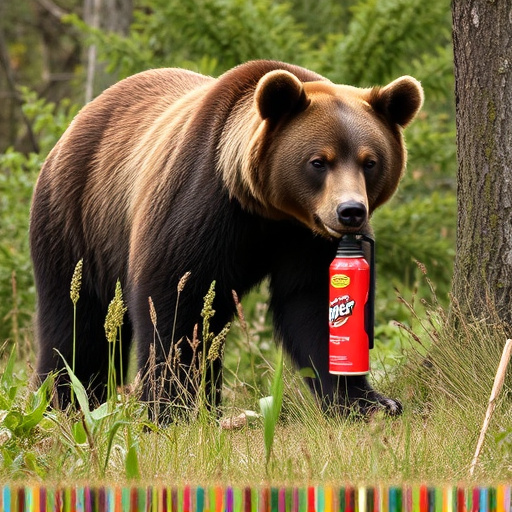Bear spray foggers, popular in Alaska for deterring bears, face environmental challenges due to decomposition. Over time, these sprays degrade, releasing chemicals that can harm aquatic life and disrupt ecosystems. The Environmental Effects of Bear Spray Decomposition highlight the need for responsible usage and proper disposal. Regular reapplication is crucial to maintain protection against bears. Concerns have led to research into sustainable alternatives like natural plant-based repellents, aiming to balance bear safety and ecosystem preservation.
Alaska’s rugged landscapes are home to powerful wildlife, including bears. Bear spray foggers have emerged as a popular defense mechanism, but understanding their environmental impact is crucial. This article delves into the intricate details of bear spray composition and its effects on Alaska’s ecosystems through decomposition processes. We explore long-term impacts and present sustainable alternatives for enhanced bear safety. By considering these factors, we contribute to a more informed approach to protecting both residents and wildlife in this pristine environment, addressing key concerns about the environmental effects of bear spray decomposition.
- Understanding Bear Spray Composition and Environmental Impact
- The Role of Decomposition in Bear Spray Efficacy
- Long-term Effects of Bear Spray on Alaska's Ecosystems
- Sustainable Alternatives and Future Considerations for Bear Safety
Understanding Bear Spray Composition and Environmental Impact
Bear spray foggers are a popular defense mechanism for outdoor enthusiasts and Alaskans alike, but it’s crucial to understand the composition of this powerful tool and its environmental impact. The active ingredients in bear spray can vary, but most commonly include capsaicin, a compound derived from chili peppers, and various other chemicals designed to deter aggressive behavior in bears. When used responsibly, these sprays can effectively create a barrier of protection without causing significant harm.
However, the Environmental Effects of Bear Spray Decomposition are worth considering. Over time, bear spray can degrade, releasing its components back into the environment. This process may have ecological consequences, particularly in sensitive ecosystems. For instance, capsaicin breakdown products can impact water quality and aquatic life, while other chemicals might disrupt local flora and fauna. Thus, proper disposal methods and responsible usage are essential to minimize these potential environmental effects.
The Role of Decomposition in Bear Spray Efficacy
The environmental effects of bear spray decomposition play a crucial role in its overall efficacy as a defense mechanism. When bear spray is deployed, it undergoes a process of breakdown and transformation in the outdoor environment. This natural process is influenced by various factors such as temperature, humidity, and exposure to sunlight. Over time, the active ingredients in bear spray start to degrade, leading to reduced concentration and potency. Understanding this decomposition process is essential for users to appreciate the duration and limitations of bear spray protection.
Decomposition enhances the environmental impact of bear spray by breaking down the protective layer it creates on potential targets. As the spray dries, it forms a thin film that repels bears by overwhelming their senses. However, as time progresses, this film weakens, allowing the spray’s effectiveness to diminish. Environmental conditions significantly contribute to this degradation, with harsher climates accelerating the decomposition process. This knowledge highlights the need for users to remain vigilant and reapply bear spray regularly in varying outdoor conditions to ensure optimal protection.
Long-term Effects of Bear Spray on Alaska's Ecosystems
The long-term environmental effects of bear spray on Alaska’s ecosystems are a growing area of concern. While bear spray is widely used for self-defense against aggressive bears, its decomposition can have surprising impacts on the environment. The chemicals in bear spray don’t simply disappear; they break down over time, potentially affecting soil quality and water sources. Research suggests that these byproducts can disrupt the natural balance of ecosystems, particularly in sensitive habitats where bears are prevalent.
When used improperly or in large quantities, bear spray can contribute to environmental pollution. The spray’s components may leach into nearby rivers, lakes, and forests, influencing not just local wildlife but also plant life and microbial communities. Understanding these long-term effects is crucial for developing sustainable practices that balance bear safety with the preservation of Alaska’s diverse ecosystems.
Sustainable Alternatives and Future Considerations for Bear Safety
As concerns over bear safety grow, it’s crucial to explore sustainable alternatives to traditional bear spray foggers. The Environmental Effects of Bear Spray Decomposition have long been a point of contention, with studies revealing potential harm to ecosystems and wildlife. Researchers are now investigating eco-friendly options that can still provide effective protection without the environmental impact. Natural repellents derived from plants and essential oils show promise as long-term solutions, offering a more harmonious approach to coexistence with bears.
Future considerations for bear safety should prioritize these sustainable alternatives, ensuring they meet the same rigorous effectiveness standards as conventional bear spray. As awareness and innovation continue, it’s vital to strike a balance between human outdoor recreation and wildlife preservation, ultimately fostering a co-existence that respects both the needs of people enjoying nature and the well-being of bear populations.
The discussion highlights the importance of understanding the environmental impact, particularly the decomposition process, of bear spray in Alaska. While it serves as a crucial defense mechanism, long-term effects on ecosystems necessitate a shift towards sustainable alternatives. By exploring eco-friendly options and considering the ecological footprint, we can ensure better bear safety while preserving the delicate balance of our natural landscapes, taking into account both human well-being and environmental considerations.
